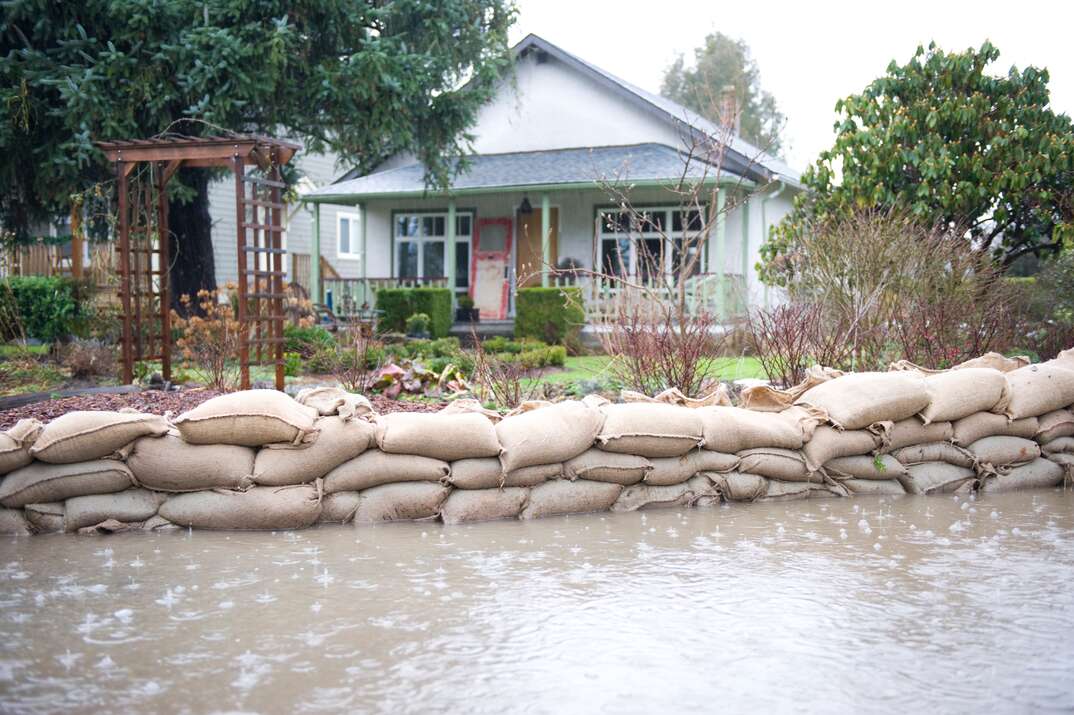How to Use Sandbags to Prevent Flooding

Can a bag full of sand really keep potentially devastating flood waters at bay? Using sandbags for flooding is a tried-and-true measure that many people living near seas and rivers take to protect their homes during hurricanes and other weather events.
This May Also Interest You: How to Create a Disaster Preparedness Plan
You can take a page out of their book to protect your home this storm season. It’s not as simple as stacking some sandbags in front of entryways. We break down this preventive project into a step-by-step guide.
How Do Sandbags Prevent Flooding?
Sandbags prevent flooding by creating a barrier for the flow of water into specific spaces, such as buildings. Stacking sandbags doesn't really create a water-tight seal, so a little bit of water does typically leak through. However, when filled and stacked correctly, sandbags can provide a sufficient barrier that keeps oncoming water mostly out of a home or business or redirects the flow of water to a more desirable location.
The method by which sandbags work is pretty simple. The pressure and weight of the sand in the bags hold the bags in place. By stacking bags in certain ways, you can create pressure and weight that creates a sort of wall against water. Obviously, sandbags do not hold up against every kind of flooding. A roaring river of water may wash away sandbags placed directly in its path, for example. When using sandbags for flooding, it's critical to know how and where to place the structures you create for optimal chances at success.
Where Can You Buy Sandbags?
You can buy bags of sand for a variety of projects at local home improvement stores as well as chain stores such as Lowe's or Home Depot. Walmart and other large department stores may also sell sandbags. For example, you might buy bags of sand for a child's play area at stores like this.
However, the prepackaged bags of sand that you buy for home improvement or other projects aren't typically what people want when they want to control water flow. First, those bags aren't designed to hold up against water in this way. Second, they may be more expensive than buying bags you can fill with cheaper sand.
You can buy burlap sandbags from local stores or online via Amazon. Don't just use grocery or garbage bags you have at home. These are too slick and will not stack correctly.
You may be able to order sand in bulk to fill these bags or get sand from local landscaping companies, home improvement stores or other businesses. In many cases, towns and cities in areas where flooding is a seasonal issue, you may be able to bring your own bags to a local organization that provides a certain amount of sand to residents free of charge or at very low costs.
More Related Articles:
- Hurricanes Happen: How Ready Is Your Home?
- How to Survey Your Home for Storm Damage
- It’s Hurricane Season! Here’s Everything You Need to Know to Prepare Your House for Storms
- Gimme Shelter: Here’s What You Need to Know About Building Home Storm Shelter
- What’s a Storm Chaser and Should You Hire Them to Fix Your Roof?
How Do You Use Sandbags to Prevent Flooding?
First, you typically have to fill the sandbags. Don't fill them all the way to the top, as you need to be able to fold the top into a triangle and down to secure the sand inside. You don't actually have to tie sandbags, as folding the open end over itself and tucking it under the bag or another bag is sufficient to keep the sand inside.
Fill sandbags a third or half of the way to the top. If you fill the bag too much, it doesn't have enough give to mold to other bags or surface areas to help keep water out.
To build a barrier against ongoing water, you lay sandbags down parallel to the water. The open end of the bags should face the direction the water is coming. Make sure to fold and tuck the ends under the bags, though.
Stack flooding sandbags as you would bricks when forming a wall. They should overlap each other to create stability. If you are building a tall barrier or expect high or strong waters, you may need to make your sandbag wall several sandbags wide.
How Many Sandbags Do You Need?
Once you know how to use sandbags, you need to know how many you might need. The average sandbag size is 14 inches by 26 inches. You can use the data below to estimate how many sandbags of this size you might need.
- 1-foot-high wall = 6 sandbags per foot of length
- 2-foot-high wall = 12 sandbags per foot of length
- 3-foot-high wall = 18 sandbags per foot of length
- 4-foot-high wall = 24 sandbags per foot of length
The exact amount of sandbags you need will also depend on the structures around you and the terrain.


